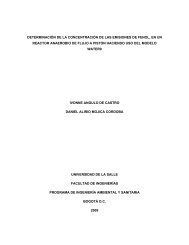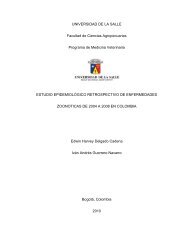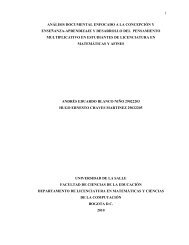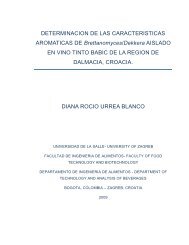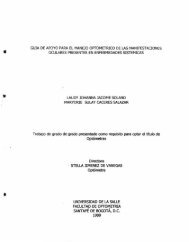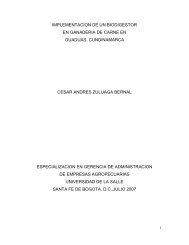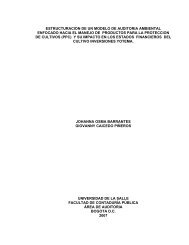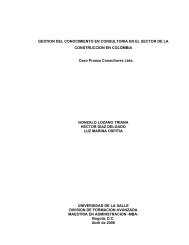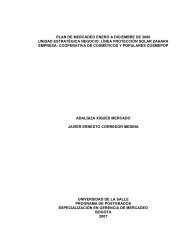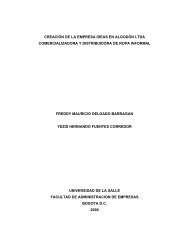- Page 1 and 2:
UNA UNIDAD DIDÁCTICA PARA LA ENSE
- Page 3 and 4:
Bogotá, 15 de Septiembre de2006 No
- Page 5 and 6:
AGRADECIMIENTOS A las Directivas de
- Page 7 and 8:
INTRODUCCION CONTENIDO 1 PLANTEAMIE
- Page 9 and 10:
4. MARCO METODOLOGICO 4.1 TIPO DE I
- Page 11 and 12:
LISTA DE CUADROS Cuadro 4. Resultad
- Page 13 and 14:
LISTA DE GRAFICAS Gráfica 1. Respu
- Page 15 and 16:
Así; la tarea del docente, no pued
- Page 17 and 18:
1 PLANTEAMIENTO DEL PROBLEMA TEMA.
- Page 19 and 20:
De esta manera, de acuerdo con lo e
- Page 21 and 22:
necesarios al concepto de función
- Page 23 and 24:
¿Identifican los estudiantes las d
- Page 25 and 26:
Universidades, siendo este fracaso,
- Page 27 and 28:
comprender el tratamiento un poco m
- Page 29 and 30:
En síntesis, las observaciones rea
- Page 31 and 32:
1.5.2 Limitaciones. Las fuentes de
- Page 33 and 34:
paterna, siendo en algunos casos, s
- Page 35 and 36:
enunciados, gráficas o expresiones
- Page 37 and 38:
linfa para desarrollarse, y por sig
- Page 39 and 40:
Los principios de aprendizaje propu
- Page 41 and 42:
La asimilación y la acomodación,
- Page 43 and 44:
ásicas en interés de la eficienci
- Page 45 and 46:
4.1 TIPO DE INVESTIGACIÓN 4 MARCO
- Page 47 and 48:
verificación (Anexo B), que involu
- Page 49 and 50:
5.1 TABLA DE CONTENIDO 5.2 LISTA DE
- Page 51 and 52:
5.5.2.1 PRESENTACION DE LA ACTIVIDA
- Page 53 and 54:
5.5.4.2.1 RELACION REFLEXIVA 5.5.4.
- Page 55 and 56:
5.5.5.10.2.2 Función Racional 5.5.
- Page 57 and 58:
5.6.2.9 INDICACIONES 5.6.2.10 INDIC
- Page 59 and 60:
Figura 14. Representación del Conj
- Page 61 and 62:
Figura 54. Representación Tabular
- Page 63 and 64:
5.4 INTRODUCCION La matemática a n
- Page 65 and 66:
5.5.1.2 MATERIALES Una hoja de p
- Page 67 and 68:
Suponga ahora, que no se toma una s
- Page 69 and 70:
una expresión matemática, que de
- Page 71 and 72:
donde N es el número de hojas, 2 e
- Page 73 and 74:
planteados, en el ejemplo de los tr
- Page 75 and 76:
Ahora bien, por $2000 se reciben $2
- Page 77 and 78:
Despejando I (interés), se tiene q
- Page 79 and 80:
F2 = P2 ( it + 1) F2 = 1070 { (0.28
- Page 81 and 82:
expresión matemática, que arroje
- Page 83 and 84:
⎛ 1 ⎞ P⎜i + 1⎟ ⎝ k ⎠
- Page 85 and 86:
Se puede escribir como: Peit Nen Co
- Page 87 and 88:
5.5.1.5.5 Cociente de dos potencias
- Page 89 and 90:
5.5.2 PAR O PAREJA ORDENADA 5.5.2.1
- Page 91 and 92:
5.5.2.4 INDICACIONES Alguna de las
- Page 93 and 94:
las cuales representan las manzanas
- Page 95 and 96:
5.5.2.5 REPRESENTACIÓN GRÁFICA DE
- Page 97 and 98:
|Para comprender mejor la represent
- Page 99 and 100:
5.5.3 PRODUCTO CARTESIANO 5.5.3.1 P
- Page 101 and 102:
¿Se conoce alguna forma de represe
- Page 103 and 104:
diagrama sagital, del plano cartesi
- Page 105 and 106:
perpendicular, a cada uno de los pu
- Page 107 and 108:
elementos del conjunto al que perte
- Page 109 and 110:
Tomando entonces los conjuntos B y
- Page 111 and 112:
Tomar ahora los conjuntos R - y R +
- Page 113 and 114:
Figura 24. Representación Cartesia
- Page 115 and 116:
cartesiano AXB, del ejemplo 2, repr
- Page 117 and 118:
5.5.4 RELACIONES Permanentemente se
- Page 119 and 120:
5.5.4.1 REPRESENTACION DE UNA RELAC
- Page 121 and 122:
Observando entonces, la representac
- Page 123 and 124:
5.5.4.2.2. RELACION SIMETRICA Dados
- Page 125 and 126: 5.5.5 RELACIONES FUNCIONALES O FUNC
- Page 127 and 128: Conocida la noticia, cada uno de es
- Page 129 and 130: Puede verse, entonces, que para cad
- Page 131 and 132: En esta relación, se puede observa
- Page 133 and 134: Observando los anteriores gráficos
- Page 135 and 136: En esta relación podemos observar
- Page 137 and 138: Los términos función y dependenci
- Page 139 and 140: De todo lo anterior se puede conclu
- Page 141 and 142: De acuerdo a lo anterior se puede o
- Page 143 and 144: 5.6 UNIDAD II 5.6.1 FUNCION EXPONEN
- Page 145 and 146: Dentro de dicho cuadrado formar un
- Page 147 and 148: El rey quiso demostrar su agradecim
- Page 149 and 150: Anótese en una tabla, la cantidad
- Page 151 and 152: Sin embargo, este procedimiento res
- Page 153 and 154: donde: m ∈ Z + U {0} y, f(m) ∈
- Page 155 and 156: f(m) = b m , donde b sería un ente
- Page 157 and 158: 5.6.1.5 FUNCIONES EXPONENCIALES DE
- Page 159 and 160: Figura 39. Representación Tabular
- Page 161 and 162: …. Calculadora …. …. Lápiz P
- Page 163 and 164: Figura 42. Representación Tabular
- Page 165 and 166: Figura 44.. Representación Tabular
- Page 167 and 168: Hallando f(x) = (1/4) x , para los
- Page 169 and 170: Hallando f(x) = (1/8) x , para los
- Page 171 and 172: Hallando f(x) = 2 x , para los valo
- Page 173 and 174: Hallando f(x) = e x , para los valo
- Page 175: Hallando f(x) = 10 x , para los val
- Page 179 and 180: Mediante la observación de las ant
- Page 181 and 182: Mediante la observación de las ant
- Page 183 and 184: Mediante la observación de las ant
- Page 185 and 186: 6. APLICACIÓN El tiempo total empl
- Page 187 and 188: Al finalizar el tratamiento de cada
- Page 189 and 190: El interés, curiosidad y disposici
- Page 191 and 192: El 25.71%, representa correctamente
- Page 193 and 194: El 57.57%, representa correctamente
- Page 195 and 196: El curso 901 superó en un 46.15% a
- Page 197 and 198: Con respecto a las preguntas de pot
- Page 199 and 200: RECOMENDACIONES Lo observado por la
- Page 201 and 202: BIBLIOGRAFIA AUSUBEL, David. Teorí
- Page 203 and 204: SABINO, Carlos A. El Proceso de Inv
- Page 205 and 206: subradical es la potencia de base x
- Page 207 and 208: PREGUNTA TIPO III Selección Falso,
- Page 209 and 210: PREGUNTA TIPO II Selección Falso,
- Page 211 and 212: 9. Dada f(x) = -2 x , complete su r
- Page 213 and 214: Son también varios los tratamiento
- Page 215: entre las cuales podemos mencionar,



